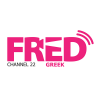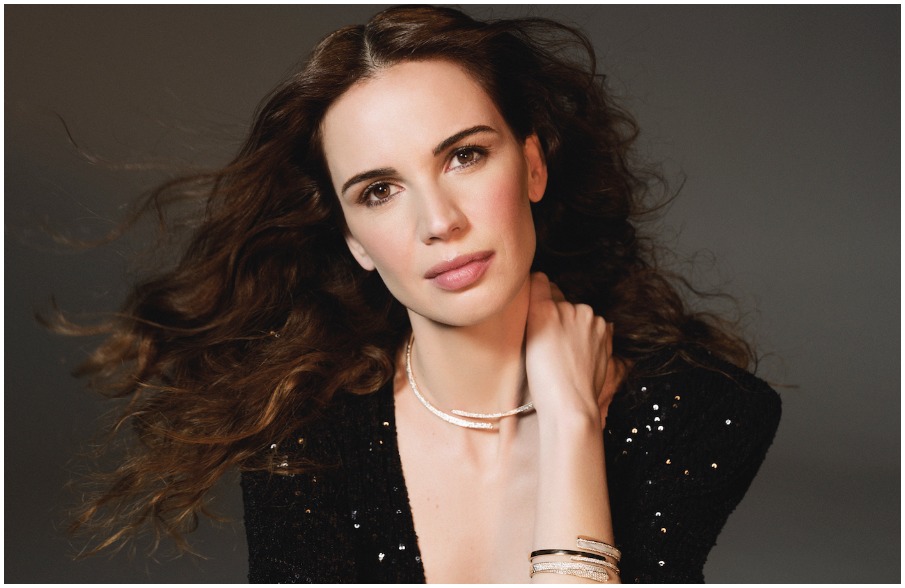Lorenza Lei, intervista alla Amministratrice Delegata della Fondazione Roma Lazio Film Commission
Inaugurata a Roma la nuova governance della Fondazione Film Commission di Roma e del Lazio.
Listeners:
Top listeners:
 play_arrow
play_arrow
ENGLISH Channel 01 If English is your language, or a language you understand, THIS IS YOUR CHANNEL !
 play_arrow
play_arrow
ITALIAN Channel 02 Se l’italiano è la tua lingua, o una lingua che conosci, QUESTO È IL TUO CANALE!
 play_arrow
play_arrow
EXTRA Channel 03 FRED Film Radio channel used to broadcast press conferences, seminars, workshops, master classes, etc.
 play_arrow
play_arrow
GERMAN Channel 04 Wenn Ihre Sprache Deutsch ist, oder Sie diese Sprache verstehen, dann ist das IHR KANAL !
 play_arrow
play_arrow
POLISH Channel 05
 play_arrow
play_arrow
SPANISH Channel 06 Si tu idioma es el español, o es un idioma que conoces, ¡ESTE ES TU CANAL!
 play_arrow
play_arrow
FRENCH Channel 07 Si votre langue maternelle est le français, ou si vous le comprenez, VOICI VOTRE CHAINE !
 play_arrow
play_arrow
PORTUGUESE Channel 08
 play_arrow
play_arrow
ROMANIAN Channel 09 Dacă vorbiţi sau înţelegeţi limba română, ACESTA ESTE CANALUL DUMNEAVOASTRĂ!
 play_arrow
play_arrow
SLOVENIAN Channel 10
 play_arrow
play_arrow
ENTERTAINMENT Channel 11 FRED Film Radio Channel used to broadcast music and live shows from Film Festivals.
 play_arrow
play_arrow
BULGARIAN Channel 16 Ако българският е вашият роден език, или го разбирате, ТОВА Е ВАШИЯТ КАНАЛ !
 play_arrow
play_arrow
CROATIAN Channel 17 Ako je hrvatski tvoj jezik, ili ga jednostavno razumiješ, OVO JE TVOJ KANAL!
 play_arrow
play_arrow
LATVIAN Channel 18
 play_arrow
play_arrow
DANISH Channel 19
 play_arrow
play_arrow
HUNGARIAN Channel 20
 play_arrow
play_arrow
DUTCH Channel 21
 play_arrow
play_arrow
GREEK Channel 22
 play_arrow
play_arrow
CZECH Channel 23
 play_arrow
play_arrow
LITHUANIAN Channel 24
 play_arrow
play_arrow
SLOVAK Channel 25
 play_arrow
play_arrow
ICELANDIC Channel 26 Ef þú talar, eða skilur íslensku, er ÞETTA RÁSIN ÞÍN !
 play_arrow
play_arrow
INDUSTRY Channel 27 FRED Film Radio channel completely dedicated to industry professionals.
 play_arrow
play_arrow
EDUCATION Channel 28 FRED Film Radio channel completely dedicated to film literacy.
 play_arrow
play_arrow
SARDU Channel 29 Si su sardu est sa limba tua, custu est su canale chi ti deghet!
 play_arrow
play_arrow
“Conversation with” at the 20th Marrakech IFF, interview with actor Willem Dafoe Bénédicte Prot
Film genres are closely connected to and were derived from literary genres, codified over millennia. Fundamentally, the theory of literary genres has not changed very much since Aristotle’s division between tragedy and comedy. Three centuries later, Horace returned to the matter but while, for Aristotle, the model had been nature, which art could only imitate, the basis for Horace was the literary model. Comedy and tragedy, often combined in Shakespeare, were brought together at the end of the eighteenth century in the new genre that led to the eighteenth century melodrama and, finally, to the film genre of the same name.
Almost immediately, films were classified by genre. In the early stages, these were unquestionably drawn from literature and the theatre but comic strips, which appeared in 1894, just a year before the invention of the cinema, also played a significant role.
What are the characteristics of a film genre? Above all, a certain repetitiveness, which means uniformity in the type of stories told, that is, the subject matter, but often also in the type of scenes, the plots, the choices of the visuals, the settings and even the characters. The significant phenomenon of stardom was important in this development since many stars were closely linked to genres: all comedians, for example, but also singers and dancers who could not have found success in the movies had it not been for the musical. In any case, the presence of a star entails a certain level of expectation and predictability on the part of the audience, even more so in the days of the star system. The power of the viewers was, in fact, almost as important as that of the industry, that is, the production side, as regards the continuing existence of genres. If a genre is not recognised and accepted by the audience, it ceases to exist. Even great critical acclaim or commercial success for a new but standalone work is certainly not enough to ensure it can be reprised.
The driving force of what can be called Hollywood’s golden era, which spanned three decades from the advent of talkies in 1927 with The Jazz Singer to the end of the fifties, when the influence of television became pervasive, can be described as the classic Hollywood style, based on the genre system.
The genre system in Hollywood was created within the studio system, based on a strict division of labour and the system of the so-called “continuity script” by which the power of the director was limited and he was prevented from indulging in sudden flights of creative fantasy that might perhaps have resulted in masterpieces but would have been disastrous for the production. In the continuity script, everything was laid down: the dialogue, the action and often the framing of the individual shot, for example, close up, long shot of a room, shot/reverse shot. Screenwriters worked alone or together in the search for ideas, gags or stories. The script was therefore often the result of a real workshop, a collective output. Once written, the script was then assigned to the director who had to film it as it was, almost without any variation.
The classification of films according to the genre to which they belonged is a fundamental aspect of cinema and, in the case of Hollywood movies, this simple label instantly told the spectator what they could expect regarding the setting, style and, within certain limits, even the ideology.
Every genre film, be it film noir, a western, a musical or another genre, is the outcome of the development of representational worlds and narrative devices that express not only a form of entertainment but also a vision of the world, a philosophy of life, an aesthetic, an ideology. With the advent of sound, genres became the dominant principle that was the starting point for the creation of a film.
We now offer a rapid overview of the most common film genres, their basic features and some concrete examples of films that best represent them.
The subject of comedy is often the integration of the hero in society, once the obstacles represented by the other characters or adverse social conditions have been eliminated. Often, there is a happy “twist”, linked to unexpected discoveries or emotional and sentimental relationships, which leads to a happy ending marked by a new and freer personal and social situation. It is characterised by the great narrative pace, the sophisticated settings, often interiors, and quick-fire dialogue full of humour.
Comedy can be classified in additional subgenres: comic, in which the characters are more stylised and played by immediately recognisable performers, as used to happen in the theatrical Commedia dell’Arte (Modern Times, Chaplin, 1936); slapstick, based on blows, pratfalls and chases, which was named after the stick used by comedians (The Cameraman, Keaton, 1928); screwball, often insanely nonsensical, with weird and surreal situations (Susanna, Hawks, 1938); finally, the sophisticated comedy, with an elegant, refined but clearly artificial atmosphere (Breakfast at Tiffany’s, Edwards, 1961). The musical is also derived from the comedy genre and features numerous songs in the film that often include real ballet performances and spectacular choreography, through which the characters express their intentions and actions (Singin’ in the Rain, Donen/Kelly, 1952).
If the comedy also touches on or deals with dramatic subjects, often connected to affairs of the heart, be they the relationship between a couple or friction within a family, the genre changes and is defined as a melodrama or mélo, with its roots not only in literature, but also the theatre and operas. Its primary features are literary simplification to the benefit of dramatic essence, the emphasis on the primary passions and the accentuation of the expressive style, while historic and existential themes and narrative digressions are kept in the background. Examples of this genre are Gone with the Wind (Fleming, 1939), Senso (Visconti, 1954), Written on the Wind (Sirk, 1956).
The western is perhaps the quintessential genre of classic American cinema. Set against the backdrop of the boundless landscapes of the West (hence the name), westerns tell stories of men and women trying to conquer new lands, natives (the “Indians”) who are fighting to avoid being overwhelmed by the advancing civilisation of the white man, and bandits who do not hesitate to attack banks and stagecoaches, steal cattle or disturb the peace of small towns. And the solitary, courageous cowboys: the real heroes of this frontier world. The first western film was The Great Train Robbery (Porter, 1903), the originator of a long series that would include very famous films like Stagecoach (Ford, 1939) and High Noon (Zinnemann, 1952) through to the reworking of the genre with the contribution of the spaghetti westerns of Sergio Leone, starting with A Fistful of Dollars (1964).
The war film genre is based on the staging of a dramatic conflict, with identifiable historical references, in which the war is not confined to the setting but provides its own dynamic in the development of the action and the personalities of the characters, as happened in Paths of Glory (Kubrick, 1957). The core narrative often concerns a particularly gripping war mission told from a one-sided perspective that paints the enemy as the source of ambushes and danger, as witness. When the war film is centred on the conduct of a great battle or significant historical events concerning an important conflict, the style takes on an epic quality and the action is more concerted, as in the films of Roberto Rossellini, Rome, Open City (1945) and Paisan (1946).
The detective film is a genre based on a plot that unfolds through the instrument of the investigation, according to a basic storyline: an initial situation of equilibrium; a reversal due to an unforeseen event (a murder, the theft of an object, the disappearance of a person); the assignment of the case to a person (in general, the leading man) who begins to investigate; the conduct of the investigation; the solving of the case, which corresponds to the restoration of the initial equilibrium.
Within the genre, there are various narrative nuances. The mystery, the heir to a great deal of nineteenth century literature and the mystery novel, with detectives who ensure reason and deduction triumph, always includes the solving of the case (Ten little Indians, Clair, 1945). The film noir or hard-boiled film, has more realism and verisimilitude, with more meticulous description of the social context and greater psychological depth of the characters, starting with the problems facing the detective (The Big Sleep, Hawks, 1946). If the main characters are not so much the detectives as the “bad guys”, the film is regarded as a gangster movie, which includes many action scenes and shoot-outs, but not at the expense of the exploration of the personalities of the characters and their social and cultural background (Scarface, Hawks, 1932). The plot of the suspense film, on the other hand, is based on conspiracy or intrigue, often connected to spying by more or less deviant secret services, from whom a victim is trying to escape (North by Northwest, Hitchcock, 1959). If the atmosphere of suspense is based more on psychological aspects, personal fear and sometimes violent plot twists, often in disturbing settings, the film is described as a thriller: examples of this were Psycho (Hitchcock, 1960) or The Silence of the Lambs (Demme, 1991).
The horror film also plays on shades of suspense and mystery but the primary objective is not solving a case so much as triggering fear and horror in those watching, resorting to ingredients such as the supernatural, the bizarre and the mysterious that provoke visual or auditory sensations, including by means of special effects and disturbing music. The stories are set in sinister places like castles, abandoned houses, cemeteries and woods, within mysterious and particular situations where ghosts, monsters, witches, demons, repellent creatures or mysterious or far-fetched beings often appear: werewolves vampires, aliens, zombies and monstrous creatures from unknown worlds. Among many films, examples include the various versions of Dracula (Browning, 1932 and Coppola, 1992), The Night of the Living Dead (Romero, 1968), The Exorcist (Friedkin, 1973) and Nightmare (Craven, 1984).
The creation of imaginary worlds is the basis of another two genres, which, however, have their own specific features, fantasy and science fiction.
The fantasy film puts the central characters at the mercy of unknown forces like magic and witchcraft, destiny and divine providence, and only a chosen few will manage to turn the situation around and overcome any difficulty with the help of their strength and determination. These characteristics are evident, above all, in stories that are linked to a universe modelled on the world of medieval Nordic sagas where the central characters are adventurers and heroines, elves and orcs, kings and wizards, as happens in The Lord of the Rings (Jackson 2001-2003), while other fantasy films are modelled more on a universe of traditional fables, as in the case of the various manifestations of Harry Potter (Columbus, Cuaron, Newell, Yates, 2001 – 2011).
Science fiction, on the other hand, is based on far-fetched predictions of scientific developments. It tells imaginary stories that, taking versions of reality to the extremes, are presented as believable with the events always following a plot that is technically and scientifically coherent or possible.
The stories may envisage future worlds that are pleasurable or otherwise and that often present dystopian visions, or deny the utopia of human progress (Fahrenheit 451, Truffaut 1966); they may be space adventures and galactic conquests, which can sometimes involve existential reflection (2001: A Space Odyssey, Kubrick, 1968); in other cases, they may combine saga and action film (Star Wars, Lucas, 1977); still others may involve an encounter or battle with aliens or robots, as occurs in different ways in Forbidden Planet (McLeod Wilcox, 1956), Close Encounters of the Third Kind (Spielberg, 1977), Independence Day (Emmerich, 1996), Matrix (Wachovski, 1999). What unites science fiction films on a stylistic level is the continuous use of spectacular special effects and the richness of the scenes of great visual spectacular.
Producing partner: Aiace Torino http://www.aiacetorino.it/
Voice talents: Dylan Ayres, Sharon Fryer
Music: Bensound – Brazilsamba (Composed and performed by Bensound http://www.bensound.com)
Written by: fredfilmradio
Guest
Film
Festival
No related posts.
Inaugurata a Roma la nuova governance della Fondazione Film Commission di Roma e del Lazio.
ShorTS International Film Festival
At the 26° Trieste ShorTS, Director Aude Léa Rapin and producer Eve Robin will hold a masterclass on their creative partnership
Al convegno Audecon sull’Accessibilità del cinema e il tax credit, il Dirigente della DG Cinema Francesco Fiorillo interviene sul ruolo del Ministero nel garantire il 100% di accessibilità delle opere cinematografiche.
Al convegno Audecon sull’Accessibilità del cinema e il tax credit, da lei organizzato, Vera Arma, fondatrice di Audecon fa un primo bilancio.





© 2023 Emerald Clear Ltd - all rights reserved.